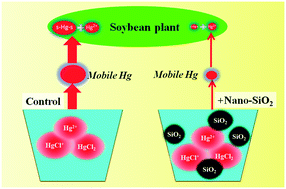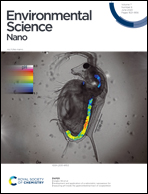Silica nanoparticles alleviate mercury toxicity via immobilization and inactivation of Hg(ii) in soybean (Glycine max)†
Abstract
Mercury (Hg) pollution is a worldwide concern. Silica nanoparticles (nano-SiO2) can be released into ecosystems through natural and anthropogenic (engineered nano-SiO2) processes. Here, the influence of two sizes (30 nm and 50 nm) of artificial nano-SiO2 on Hg accumulation in soybean plants, the chemical form and distribution of Hg in plant tissues and the levels of chlorophyll and antioxidant enzymes in plants were investigated. The results showed that both sizes of nano-SiO2 amendments alleviated the growth inhibition induced by Hg and reduced the accumulation (62.2–83.6% in roots; 67.9–75.7% in stems; 45.0–70.7% in leaves lower with nano-SiO2 amendments vs. Hg-only exposure) and translocation (transport rates: 0.18–0.19 with nano-SiO2 amendments vs. 0.22–0.26 Hg-only exposure) of Hg in soybean seedlings. Compared with the Hg-only exposed groups, nano-SiO2 amendments significantly reduced the Hg concentrations in the epidermis and pericycle of the roots and stems, especially the pericycle measured by synchrotron radiation X-ray fluorescence (SRXRF). The application of nano-SiO2 also ameliorated the chlorophyll decrease (15.3–50.1% higher with nano-SiO2 amendments vs. Hg-only exposure) and antioxidant enzyme increase (20.7–33.2% lower with nano-SiO2 amendments vs. Hg-only exposure) induced by Hg stress. Additionally, the RS–Hg–SR bonding form in the roots of nano-SiO2 treated groups significantly decreased when compared with that of Hg-only exposed groups, and over 85% of the total Hg content was present in the form of R–Hg–Cl, which was largely consistent with the original Hg exposure species and indicated a low incorporation rate of Hg into plant tissues. This study explored the mechanism of nano-SiO2 against Hg toxicity in plants, and offered a new passivating agent option for Hg remediation.



 Please wait while we load your content...
Please wait while we load your content...